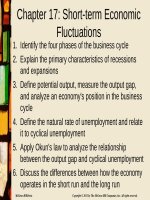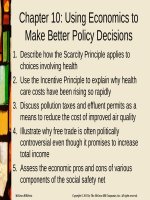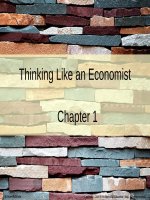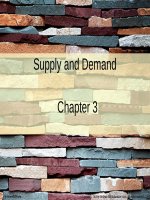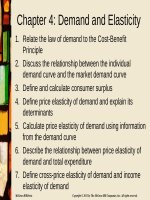Lecture Principles of economics (Brief edition, 2e): Chapter 10 - Robert H. Frank, Ben S. Bernanke
Bạn đang xem bản rút gọn của tài liệu. Xem và tải ngay bản đầy đủ của tài liệu tại đây (328.65 KB, 22 trang )
Chapter 10: Using Economics to
Make Better Policy Decisions
1. Describe how the Scarcity Principle applies to
choices involving health
2. Use the Incentive Principle to explain why health
care costs have been rising so rapidly
3. Discuss pollution taxes and effluent permits as a
means to reduce the cost of improved air quality
4. Illustrate why free trade is often politically
controversial even though it promises to increase
total income
5. Assess the economic pros and cons of various
components of the social safety net
McGrawHill/Irwin
Copyright © 2011 by The McGrawHill Companies, Inc. All rights reserved.
Health Care Delivery
• Health care spending has grown faster than income
– Up from 4% of national income in 1940 to 16% in 2010
– Part of the increase is due to improved quality of tests,
procedures, drugs, etc.
– Part is due to the third-party payment system
• Growth in use of insurance for payments (Employer-provided
and government-provided)
• Cost-benefit test assures efficient allocation of health care
– Perform a service only if the benefit exceeds the cost
• Costs are easy to measure
• Benefits are complicated
– Usual measure is willingness to pay marginal cost
• Some patients are unable to pay for basic services
(government-provided insurance)
– Confused by third-party payment system
102
Health Care for Employed
• Employer pays insurance
Medical
on behalf of employee
Employer
Provider
– Employees pay part of
the insurance premiums
• Medical provider cares for Insurance
Patient /
patient / employee
Company
Employee
– Patient co-pay
• Medical provider bills insurance
– Insurance company pays provider
• Insurance company periodically reviews employer's
policy and adjusts rates
103
Insurance, Demand, and Waste
• Amount of waste from full insurance depends on
the price elasticity of demand for medical
services
• Research compared patients with first dollar
coverage to those with $1,000 deductibles
– First-dollar coverage pays all expenses for the
insured's health care
– $1,000 deductible pays all expenses after the
patient has paid $1,000
– Deductible patients spent 40 – 50% less on health
care and had the same health outcomes
104
Policy Implications
• Research shows that when individuals pay for
their health care, they consume less
• A more efficient system can be designed
– Adopt a system of high deductible health insurance
– Use stipend payments for the poor
• An efficient policy will increase the size of the
health care pie
105
Health Maintenance
Organization (HMO)
• A Health Maintenance Organization is a group
of physicians that provides health services for a
fixed annual fee
– Reduced incentives to prescribe expensive tests
• The doctor receives no additional fee for prescribing
and interpreting tests
• In most cases, diagnoses and treatment will be
the same with conventional health insurance and
with an HMO
– HMO costs less than conventional health insurance
106
US Health Insurance
• In 2007, 47 million Americans had no health insurance
– Cost of a policy for a family of 4 generally exceeds annual
health spending for the family
– Stigma of being irresponsible is fading
– Adverse selection problem
• If the healthy opt for no insurance, the insured are those with
known health problems or risks (Raises costs for remaining
insured)
• A possible solution
– Government payment of $5,000 to each family
– Health care market efficiency increases
• Patients decide, not insurance companies
– Cost to government would be $350 billion per year
• Higher taxes offset by higher salaries and reductions in highcost care for the uninsured
107
Price Incentives and the
Environment
• Goods with negative externalities tend to be
overproduced
• Social objective is to reduce pollution by half
from its unregulated level
– The most efficient solution is one where the
marginal cost of pollution abatement is the same for
all polluters
• Cost data are not available to government
– One solution is to have all reduce pollution by the
same proportion
• Uneven distribution of costs
108
Taxing Pollution
• If tax is $T per ton, the firms will reduce pollution
as long as the cost of reductions is less than $T
• A tax of $101 moves Sludge to B and NW Lumber
to D
• Total cost is $100 for Sludge + $180 for NW =
$280/day
– Net savings of $300/day over regulation
Cost of Production and Amount of Smoke Emitted
Process
(smoke)
A
(4 T/day)
B
(3 T / day)
C
(2 T/day)
D
(1 T/day)
E
(0 T/day)
Sludge Oil
($/day)
$100
$200
$600
$1,300
$2,300
NW Lumber
($/day)
$300
$320
$380
$480
$700
109
Price Incentives and the
Environment
• Taxing pollution concentrates pollution reduction
in firms that can accomplish it at the least cost
– Cost – Benefit Principle
– Cost of the last ton of smoke removed is the same
for all firms
• It can be difficult to determine the optimal tax
rate
– Set the tax too high and you get too little reduction
– Set the tax too low and you get too much reduction
• Marginal cost exceeds marginal benefit to society
1010
Auctioning Pollution Permits
• Set a target level for total pollution allowed
– Auction 4 permits to allow 4 tons/day
• Determine price of a permit, who buys them, and
the total cost of pollution reductions
Cost of Production and Amount of Smoke Emitted
Process
(smoke)
A
(4 T/day)
B
(3 T / day)
C
(2 T/day)
D
(1 T/day)
E
(0 T/day)
Sludge Oil
($/day)
$100
$200
$600
$1,300
$2,300
NW Lumber
($/day)
$300
$320
$380
$480
$700
1011
Auctioning Pollution Permits
Cost of Production and Amount of Smoke Emitted
Process
(smoke)
A
(4 T/day)
B
(3 T / day)
C
(2 T/day)
D
(1 T/day)
E
(0 T/day)
Sludge Oil
($/day)
$100
$200
$600
$1,300
$2,300
NW Lumber
($/day)
$300
$320
$380
$480
$700
Benefit of Permits
# permits
1
2
3
4
Sludge Oil
($/day)
$1,000
$700
$400
$100
$220
$100
$60
$20
NW Lumber
($/day)
1012
Resistance to International Trade
• International trade benefits both exporting country and
importing country
– Exporter gets a higher price abroad than he could
get at home
– Importer pays less than he would pay for the same
product made domestically
• Blockades and sanctions limit a country's trade
– Civil War blockade of the South
– Current trade sanctions against Iran
• Opposition focuses on groups who lose from free
trade and ignores the benefit to the economy as a
whole
1013
Resistance to International Trade
• Suppose Brazil has a comparative advantage in coffee
and the US has a comparative advantage in
computers
– If Brazil allows the free importation of computers,
Brazilians get more computers and pay a lower
price
– Brazilian computer manufacturers are harmed
• Price has decreased, so inefficient firms fail
• Surviving firms earn lower profits
• In general -– Consumers are helped by imports
– Domestic producers of imported goods are hurt by
free trade
1014
Resistance to International
Trade
• Suppose Brazil exports coffee to the US
– Price of coffee in Brazil increases, hurting domestic
consumers
– Producers of coffee benefit from a higher price and
a larger market
• In general -– Consumers are hurt by exports
– Domestic producers of exported goods benefit from
free trade
1015
Restricting Trade
• Protectionism is the view that free trade is
injurious and should be restricted
• "Protecting" domestic markets is achieved in
several ways
– A tariff is a tax on an imported good
• Raises the price of the import and reduces quantity
imported
– A quota is a legal limit on the quantity of a good
that can be imported
• Reduces supply of imports and increases the market
price for the good compared to free trade
1016
Income Redistribution
• Raising incomes of the needy reduces the
incentive to work
– Difficulty distinguishing between needy and others
• Risk takers may appear "needy"
• People who prefer not to work ineligible
• Hurricane victims
• No perfect solution
– Choose among imperfect alternatives
1017
Welfare Payments and In-kind
Transfers
• In-kind transfers are direct transfers of goods
or services
– Food stamps, Medicaid, public housing, free school
lunches
• From mid 1960s to 1996, Aid to Families with
Dependent Children (AFDC) provided cash
– Sometimes required no adult male in the household
• Destabilizing for families
– Created persistent dependence on AFDC
1018
Means-Tested Benefit Programs
• A means-tested program decreases benefits as
the recipient's other income increases
– Intends to avoid paying benefits to those who can
support themselves
• Administrative structure discourages work
– If benefits are reduced by $1 for each $2 earned,
participants in multiple programs may lose more
benefits than the income they earn
• Administrative costs are high
– Simplify the program and distribute the cost savings
to the needy
1019
Earned Income Tax Credit
(EITC)
• An earned-income tax credit is a policy under
which low-income workers receive credits on
their federal taxes
• A family of four earns $15,000
– EITC is $4,750
– Federal taxes are reduced by $4,750
• If taxes are less than EITC, a refund is issued
• EITC does not interfere with market incentives
– Affects only people who work
– Allows labor markets to reach equilibrium
1020
Public Employment for the Poor
• Overcomes the shortcomings of the EITC and
NIT
– EITC does not help the unemployed
– NIT reduces the incentive to work
• Government could employ the poor
– If wages are the same as the private sector, some
workers will prefer government jobs
• Increases the cost of the program
– Make-work programs are not productive
– Increases size of government
1021
A Combination of Methods
– Use a NIT with payment set below the poverty
threshold
– Set the public service wage below the minimum
wage
– Privatize the management of the public service
employment program
Public
Job
Poverty
threshold
NIT +
Public Job
NIT +
Private Job
NIT
1022

